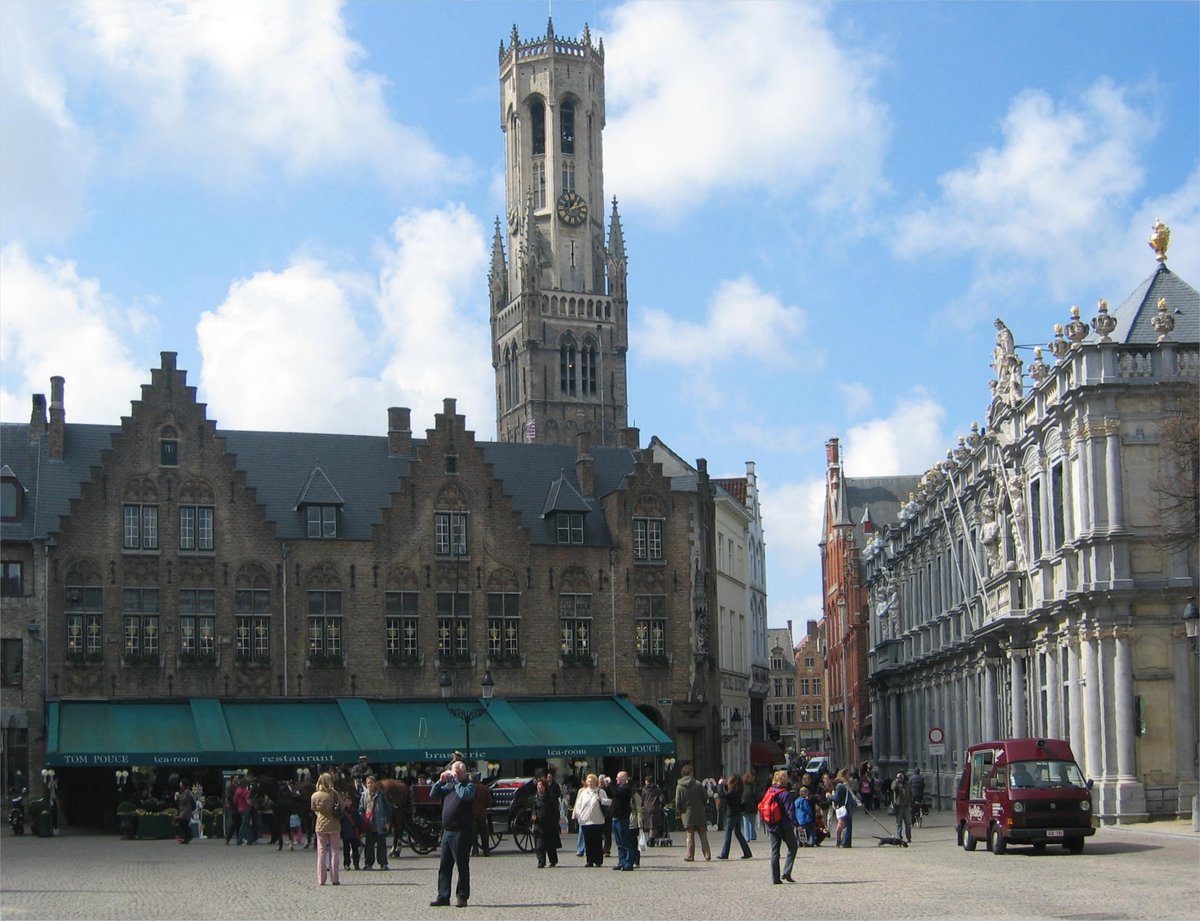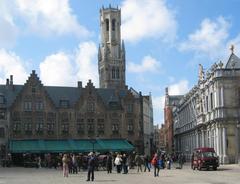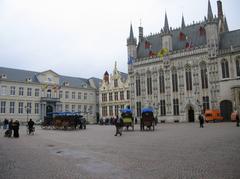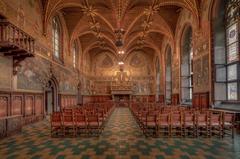
Burg Square, Bruges, Belgium: Visiting Hours, Tickets, and Historical Sites Guide
Date: 14/06/2025
Introduction: Burg Square’s History and Cultural Significance
Nestled in the heart of Bruges, Belgium, Burg Square—locally known as “the Burg”—is a stunning testament to the city’s medieval past, architectural splendor, and vibrant civic heritage. Established in the 9th century by Baldwin I, Count of Flanders, as a fortified stronghold against Viking raids, the Burg has evolved into Bruges’ administrative and spiritual nucleus. Today, it captures centuries of Flemish history through its blend of Romanesque, Gothic, Renaissance, Baroque, and neo-Gothic landmarks. It is also a designated UNESCO World Heritage Site, reflecting both the city’s architectural diversity and enduring historical importance.
This guide delivers comprehensive insights on Burg Square’s visiting hours, ticketing, accessibility, key attractions, and travel tips—helping you plan a meaningful visit to one of Bruges’ most iconic destinations (tompoucebrugge.be; thecitytripper.com; traveltoer.com; visitbruges.be).
Table of Contents
- Introduction
- Origins and Early History
- Architectural Evolution of the Burg
- Visiting the Burg: Practical Information
- Key Attractions
- Civic and Religious Significance
- The Burg Today
- Travel Tips and Accessibility
- Frequently Asked Questions (FAQ)
- Conclusion and Final Tips
- References
Origins and Early History
The name “Burg” derives from the Latin “burgus,” meaning fortress. Between 865 and 875 CE, Baldwin I fortified this location to protect Bruges from external threats. Although the original fortifications are gone, this strategic site became the core of Bruges’ civic and religious development, shaping its rise as a medieval power (tompoucebrugge.be).
Architectural Evolution of the Burg
Burg Square showcases 800 years of architectural change, each style narrating a chapter in Bruges’ story:
- Romanesque: The 12th-century lower chapel of the Basilica of the Holy Blood is the oldest surviving structure, with distinctive rounded arches and sturdy columns.
- Gothic: The City Hall (Stadhuis, 1376–1421) exemplifies high Gothic civic architecture, boasting an ornate façade and pointed arches. The basilica’s upper chapel also features late Gothic stonework and stained glass.
- Renaissance and Baroque: The Old Civil Registry (Oude Civiele Griffie, 1537) and the Brugse Vrije integrate Renaissance symmetry, classical proportions, and Baroque details, reflecting Bruges’ evolving cultural influences.
- Neo-Gothic and Modern: 19th- and 20th-century additions, such as the Tompouce Brugge house, revive medieval aesthetics with modern craftsmanship (tompoucebrugge.be).
Visiting the Burg: Practical Information
Opening Hours
- Burg Square: Open to the public 24/7.
- Basilica of the Holy Blood: Daily, 9:30 AM–12:00 PM & 2:00 PM–5:30 PM.
- City Hall (Stadhuis): Usually Tuesday–Sunday, 9:30 AM–5:00 PM.
- Brugse Vrije: Tuesday–Sunday, 10:00 AM–5:00 PM.
- Old Civil Registry: Not open to the public, but its façade can be admired from the square.
Check official websites for seasonal variations or closures during public events.
Tickets
- Burg Square: Free access.
- Basilica of the Holy Blood: Free entry; voluntary donations appreciated. Treasury/museum: ~€2.50.
- City Hall Museum: ~€7–8 for adults; combined tickets with Brugse Vrije available.
- Brugse Vrije: Entry included with City Hall ticket.
Accessibility
- The square is paved with cobblestones; ramps are available at major attractions, but some uneven surfaces may challenge wheelchair users.
- Most main sites have wheelchair access, though some historic interiors may have limited accommodations.
- Public restrooms (fee required) and limited benches are available.
Key Attractions
Bruges City Hall (Stadhuis)
A Gothic masterpiece built between 1376 and 1421, the City Hall features elaborate stonework, statues, and the impressive Gothic Hall, adorned with vaulted ceilings and murals. Still an active administrative building, it partially opens its historic rooms to visitors (traveltoer.com).
Basilica of the Holy Blood
This double church combines a Romanesque lower chapel and a richly decorated Gothic upper chapel. It houses a venerated relic believed to contain Christ’s blood, displayed daily and paraded each May during the UNESCO-recognized Procession of the Holy Blood (thecitytripper.com).
Old Civil Registry (Oude Civiele Griffie)
Dating from 1537, this Renaissance building boasts a gilded façade with restored statues and intricate carvings symbolizing Bruges’ civic pride (thecitytripper.com).
Brugse Vrije (Liberty of Bruges)
This former courthouse and administrative center features Gothic and Renaissance elements, with an ornate 16th-century fireplace by Lanceloot Blondeel. It now houses city archives and is partially accessible to visitors with a City Hall ticket (Flyalong).
Tourist Office and Urban Garden
The main tourist office offers maps, multilingual support, and tour information. The square’s urban garden and occasional public art installations provide a peaceful spot to relax.
Civic and Religious Significance
Since the 14th century, Burg Square has been Bruges’ political heart, with City Hall as the seat of municipal government and Brugse Vrije overseeing regional administration. The Basilica of the Holy Blood attracts pilgrims worldwide, especially during its renowned annual procession (thecitytripper.com). The square hosts festivals, civic ceremonies, and seasonal markets, cementing its role as a living center of Bruges’ cultural and community life.
The Burg Today: Experience and Explore
Burg Square offers a dynamic blend of medieval grandeur and present-day vibrancy. Visitors can:
- Admire the architectural diversity and intricate façades.
- Visit museums and religious sites.
- Attend annual events such as the Procession of the Holy Blood or open-air concerts.
- Enjoy photographic opportunities, especially during early morning or late afternoon light.
Interactive maps and virtual tours are available via Bruges’ official tourism platforms, enhancing navigation and planning.
Travel Tips and Accessibility
- Best Times to Visit: Early mornings or late afternoons for fewer crowds and optimal photography; May for the Holy Blood Procession.
- Attire: Modest clothing is recommended for religious sites.
- Languages: Flemish is spoken, but English, French, and German are common; signage includes English.
- Getting There: The square is a 2-minute walk from the Markt. Cycling is not permitted in the square, but racks are nearby. Public parking is within walking distance.
- Dining: Enjoy Belgian specialties at nearby cafés; for better value, try side streets.
Frequently Asked Questions (FAQ)
Q: What are Burg Square’s visiting hours?
A: The square is open 24/7. Main attractions are generally open from 9:30 AM to 5:00 PM; check official sites for seasonal variations.
Q: How much do tickets cost?
A: The square and Basilica are free. City Hall and Brugse Vrije require tickets (typically under €10); combined tickets are available.
Q: Is Burg Square accessible for wheelchair users?
A: The square is cobblestoned, but ramps are provided at primary sites. Some interiors may be less accessible.
Q: Are guided tours available?
A: Yes, guided and audio tours are offered through the Tourist Office and local operators.
Q: When is the best time to visit?
A: Early mornings, late afternoons, or shoulder seasons (April–May, September–October) to avoid crowds.
Conclusion and Final Tips
Burg Square stands as an essential Bruges destination, encapsulating a millennium of history, architecture, and civic life. Marvel at the Gothic grandeur of City Hall, contemplate the sacred relic in the Basilica, and enjoy the Renaissance artistry of the Old Civil Registry and Brugse Vrije. With accessible visiting information, guided tours, and year-round events, the Burg welcomes everyone—from history enthusiasts to casual travelers. For the best experience, visit in the early morning or late afternoon, consult official resources for updates, and consider using apps like Audiala for guided insights.
Burg Square is more than a historical site—it’s a living museum and the beating heart of Bruges (tompoucebrugge.be; thecitytripper.com; visitbruges.be).
References and Further Reading
- History of the Burg - Tompouce Brugge
- Burg Square in Bruges - The City Tripper
- 20 Historical Sites to Visit in Bruges - Traveltoer
- Most Historic Buildings and Sites in Bruges - Wanderlog
- Bruges: What to See - Rough Guides
- Architectural Styles in Bruges - Giggly Garden
- Things to Do in Bruges - Thoroughly Travel
- 15 Best Things to Do in Bruges - The Crazy Tourist
- Official Bruges Tourism Website
For more curated guides and real-time updates, download the Audiala app and follow us on social media for exclusive travel insights!













































































